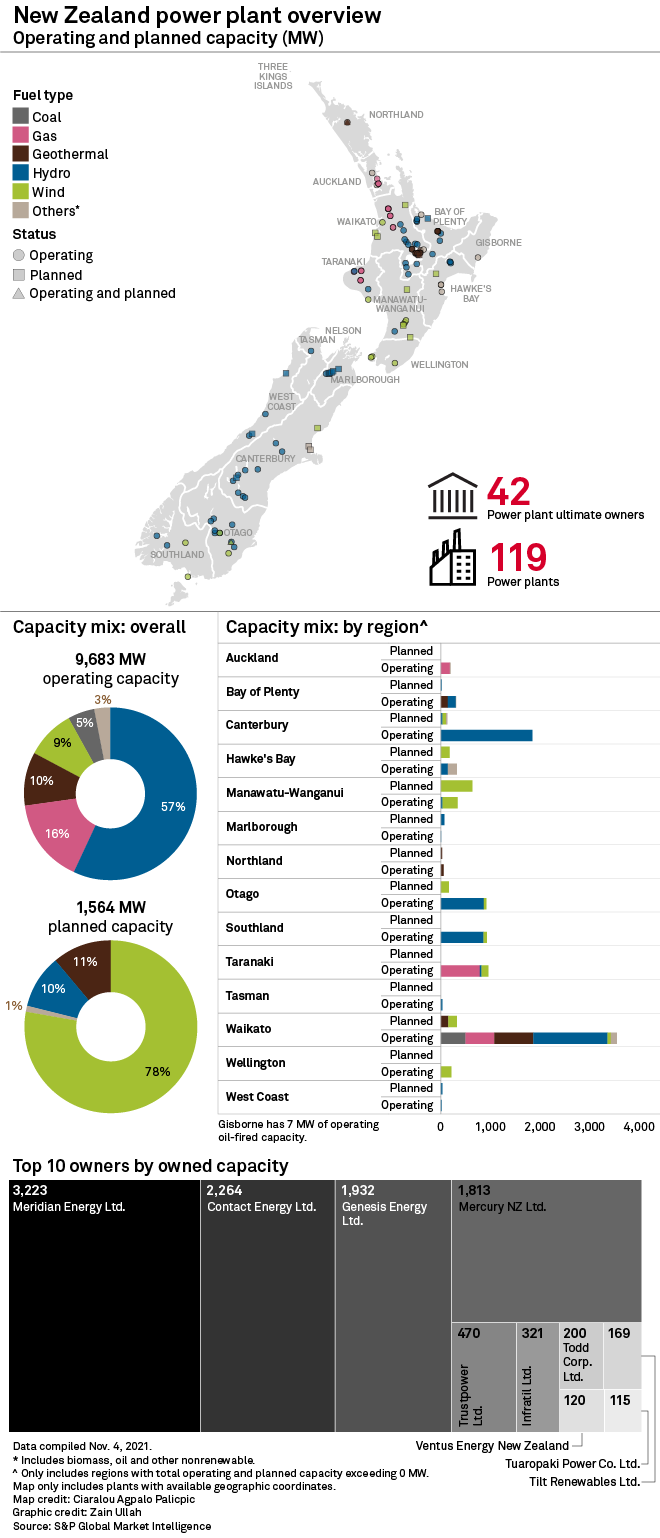S&P Global Offerings
Featured Topics
Featured Products
Events
S&P Global Offerings
Featured Topics
Featured Products
Events
S&P Global Offerings
Featured Topics
Featured Products
Events
Banking & Capital Markets
Economy & Finance
Energy Transition & Sustainability
Technology & Innovation
Podcasts & Newsletters
Banking & Capital Markets
Economy & Finance
Energy Transition & Sustainability
Technology & Innovation
Podcasts & Newsletters
S&P Global Offerings
Featured Topics
Featured Products
Events
9 May, 2022
By Michael Lustig and Anna Duquiatan
About 20% of New Zealand's nearly 10 GW of operating power generation capacity is comprised of gas- and coal-fired resources, but those will soon be replaced as the country aims toward a 2030 deadline for a 100% renewable energy portfolio.
New Zealand also has a net-zero emissions target of 2050.
The majority of New Zealand's existing generating capacity comes from hydro resources, according to S&P Global Market Intelligence data. More than 75% of nearly 1.6 GW of planned capacity is wind.

Four utilities own the bulk of the country's generation resources, with Meridian Energy Ltd. owning the most, according to Market Intelligence. Meridian's portfolio includes the country's largest hydro plant, Manapōuri, at 854 MW.
Contact Energy Ltd., the country's second-largest owner of power generation capacity, said in February that it was increasing the output of its planned Tauhara Geothermal Plant from 152 MW to 168 MW, but that its targeted start date would be pushed back from mid-2023 to later that year. Overall costs for Tauhara were projected to increase by NZ$140 million, to NZ$818 million. Contact Energy CEO Mike Fuge cited various impacts of the pandemic, including worker availability and supply chain constraints.
Genesis Energy Ltd. owns New Zealand's largest power plant, the Huntly complex. The four-unit coal-fired Huntly Steam Power Plant began operating in the first half of the 1980s. Two units, each with 250 MW, are currently operating and a third is mothballed, while a fourth has been retired. These units can also run on natural gas.
The Huntly Unit 6 (P40) Power Station is a 50.8-MW unit operating since 2004 that can run on natural gas or diesel and is used as a peaking unit. The Huntly Unit 5 (E3P) CC Power Station is a combined-cycle gas-fired unit that began operating in 2007 and can produce 385 MW. In a statement discussing its first-half fiscal year 2022 financial performance, Genesis said the Huntly station could serve as a backup resource during a low hydro year or when renewable resources are less available.
Genesis has also contracted for a portion of the output of Contact Energy's Tauhara plant starting in 2025.
The fourth-largest power supplier, Mercury NZ Ltd., is building what will be the country's largest wind facility, the 204-MW Turitea Wind Farm. A portion is operating, with the remainder under construction. All of the company's other existing power generation assets are hydro or geothermal.
The New Zealand government owns a 51% interest in Meridian, Genesis and Mercury. The government also owns the high-voltage transmission system through a company called Transpower. The grid operates at 220 kV. A high-voltage, direct-current line completed in 1965 links New Zealand's North Island and South Island.
On March 28, the New Zealand government-backed investment fund NZ Super Fund and Denmark-headquartered energy asset investor Copenhagen Infrastructure Partners K/S said they were launching a feasibility study of 1 GW of offshore wind resources in the South Taranaki Bight, which could potentially be expanded to 2 GW, off the southwest of New Zealand's North Island.
In April, Belgium-headquartered offshore wind developer Parkwind NV hired a country manager for New Zealand and Australia as part of a move beyond Europe and as New Zealand's government begins to develop a regulatory framework for offshore wind development.
